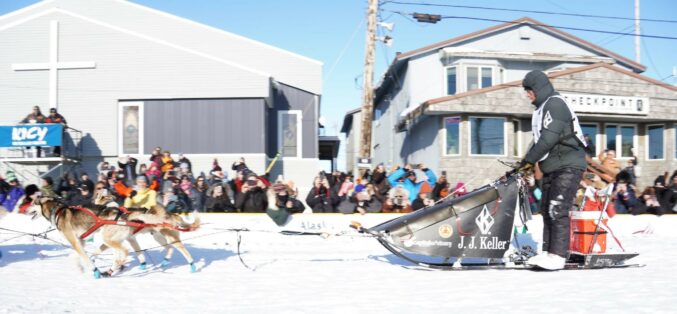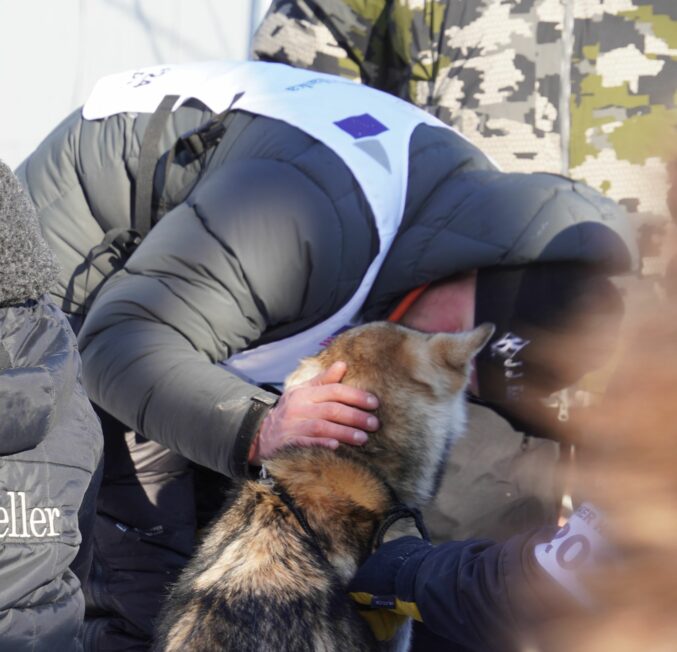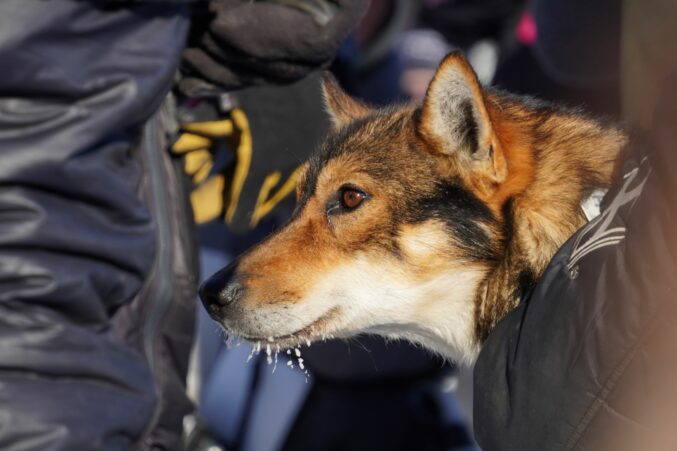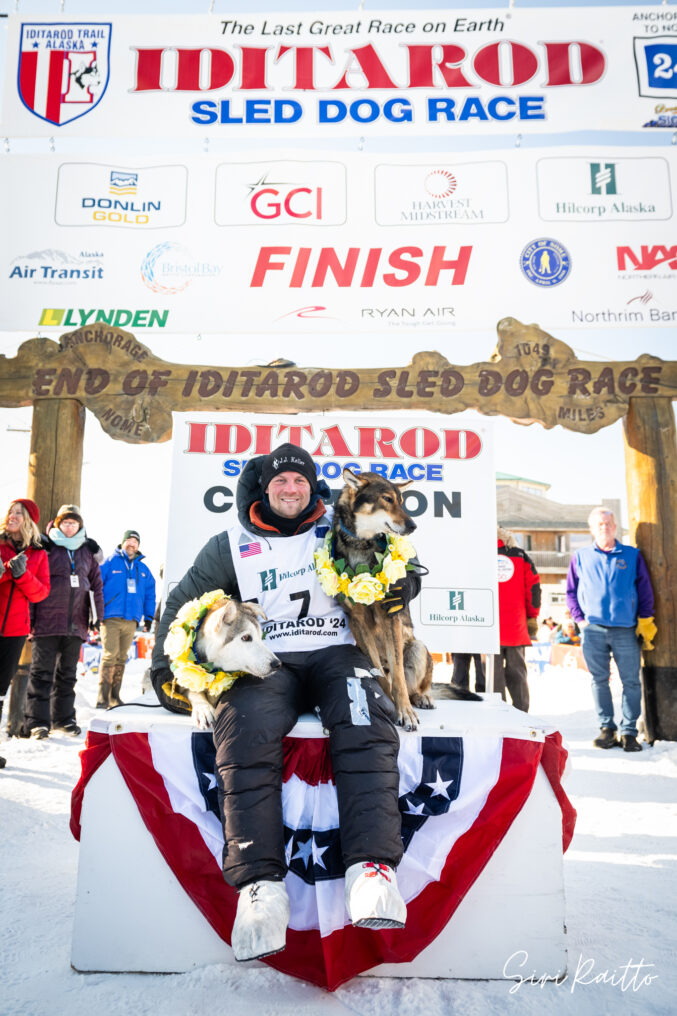Today Dallas Seavey won the 2024 Iditarod, earning a record-breaking six championships. He crossed the finish line under the Burled Arch at 5:16 pm Alaska time with ten dogs. Dallas honored his lead dogs Aero and Timon, saying, “they brought the team home for everyone.” It was amazing to be right on Front Street in Nome watching the team come into the finish line. After the mandatory gear check, Dallas was declared the winner!

Dallas mushes to the finish line of his sixth Iditarod win. Photo: K. Newmyer
As race fans and classrooms around the country watched the Iditarod unfolding over the last 9 days, it became clear that Dallas, despite obstacles, was pulling ahead. I wondered, what was making him the winning team? What is it about Dallas’s style of racing that makes him so good? How did he take care of his dogs, and what approach does he have to a good run/rest schedule? How does he handle adversity?
In his interview at the finish line, Dallas said important things that apply to education, too. What stood out to me especially was, “we run the race one step at a time.” He actually mentioned this a couple of times! I personally love this idea and remind myself of it when things get hard. It’s important for both students and teachers alike not to get overwhelmed, but to focus on tackling tasks one at a time. Students might look at a practice sheet of math problems, vocabulary words, or science concepts and think, “I’ll never learn all this.” It’s up to us teachers to give students “practical and real” ways, as Dallas said, to tackle the task right in front of them. “You can’t swallow 1,000 miles in one bite, but you can do it a step at a time. We will stumble, but we’ll pick ourselves up and take another good step. If you keep doing that, it leads to something.”

Dallas shares his perspective with the crowd. Photo: K. Newmyer
One thing people really enjoy about the Iditarod is the fact that it is a lengthy race, going across many different landscapes and cultures. It also comprises many different communities where the checkpoints give mushers access to the things they need to care for themselves and their teams. Fans can watch as teams progress down the trail—first starting in Willow, then crossing the mountains and reaching the Yukon River, then reaching the Bering Sea coast and traveling over the ice to Nome. Spectators, families, friends and fans can understand how the race really has to be done one step at a time.
Teachers also need to be intentional about helping students get right to work. This might be as simple as creating a sense of excitement, explaining the reason why they are doing a learning activity, creating a place for students to post and share their completed work, or celebrations of accomplishment that they can look forward to participating in. I like to break the actual doing of work tasks into small chunks. Before I have students write or do a social studies activity, I give them some thinking time. This helps them be more productive when it’s time to put pencil to paper. Taking time to strategize about an assignment mimics the way Dallas analyzes every aspect of his race performance. We can help students do this by first reminding them of their success criteria, which I talked about in yesterday’s post, then giving them time to think. After they’re done deciding about how to approach the problem, be their coach and caretaker, just like Dallas did for his dogs every step of the trail.

Dallas gives his lead dog some love. Photo: K. Newmyer
When students are finished and you’ve assessed their performance, help students analyze what went right and what could be better. Dallas has had plenty of time to do this over his lifetime of raising dogs from puppies, training them, and running races. Every time he completes a race, he analyzes the performance of his team. A lot of students might not be confident to look at their mistakes or misconceptions this way but remind students that this is where most of their learning takes place!
Another thing that really stood out to me was when Dallas said, “none of the dogs were superstars, but they had heart, and they were a team.” A group of superstars can’t really function as a team—they are too busy trying to be superstars. By valuing each member’s contribution, no matter how small, you can start to create a really successful team. I think this a great approach to any athletic or class culture initiatives you may have for your students.

Dallas Seavey’s dog Aero, 2024 Iditarod leader. Photo: K. Newmyer
How do you teach heart? I’m not exactly sure but I do know that when I share Iditarod stories, especially of the dogs, students get emotionally involved. They love hearing how Douggie learned to be a great sled dog and helped the team avoid disaster, and they love hearing about Anna, and how she proved she was good enough to be a leader, even though she was small. It’s great inspiration to remind students of when they are struggling. Although it’s a tradition for the Iditarod champion to get a photo with his or her lead dogs draped in yellow rose garlands, Dallas reminded his fans that Aero and Timon represented the entire team. Share the stories and photos of all the dogs who trotted 1,000 miles happily and still kept wagging their tails at the finish line.

Dallas Seavey with lead dogs Aero and Timon at the 2024 finish line. Photo: Siri Raitto
If you haven’t read Dallas’ memoir, Born to Mush, I encourage you to do so. He writes about his winning mentality and his willingness to work hard for what he wanted. Students can make posters to put up around the school that express the lessons Dallas mentioned at the finish line today: Go one step at a time, analyze your performance to do better next time, and always think about what your team needs. By emulating Dallas Seavey’s life lessons that he practiced during his record-breaking sixth Iditarod win, your students will become more confident learners. Share with me how you plan to teach these winning life lessons. Email me at emailtheteacher@iditarod.com.


